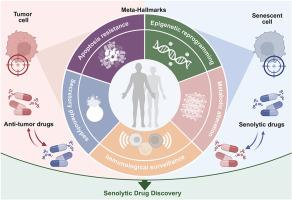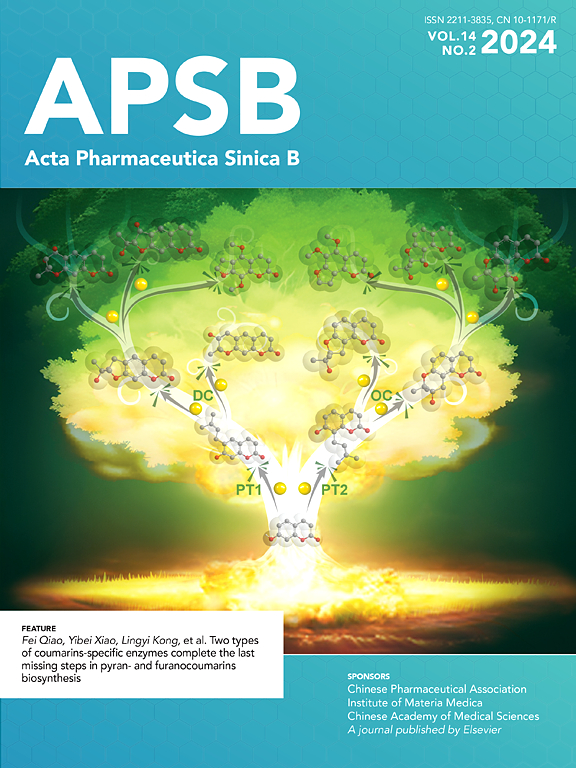揭示衰老和肿瘤细胞之间的元标记:抗衰老药物发现的新视角
IF 14.6
1区 医学
Q1 PHARMACOLOGY & PHARMACY
引用次数: 0
摘要
衰老和癌症具有重叠的特征,被称为元标记,它阐明了衰老和癌症之间的趋同、拮抗或矛盾关系。同样,作为衰老的一个关键特征,衰老细胞与肿瘤细胞共享一些元标记。这些特征包括细胞凋亡抵抗、代谢改变、分泌表型、表观遗传重编程和免疫监视,所有这些在肿瘤发生和衰老中都起着关键作用。此外,抗衰老药物是一类选择性地消除衰老细胞的药物,已成为肿瘤和衰老相关疾病的有前途的治疗药物。自2015年发现第一种抗衰老药物以来,各种各样的抗衰老药物被开发出来。值得注意的是,大多数抗衰老药物都是从现有的抗肿瘤疗法中改造而来的,利用它们与衰老细胞和肿瘤细胞的共同机制。因此,这篇综述探讨了衰老细胞和肿瘤细胞之间的相似性,提供了对元标记的更好理解。此外,我们还根据元标记对现有的抗衰老药物进行了分类,并阐明了其作用的潜在分子机制。通过整合癌症和衰老研究的见解,这项工作旨在激发抗衰老药物发现的创新策略。本文章由计算机程序翻译,如有差异,请以英文原文为准。

Unraveling the meta-hallmarks between senescent and tumor cells: A new perspective for senolytic drug discovery
Aging and cancer share overlapping characteristics, referred to as meta-hallmarks, which elucidate the convergent, antagonistic, or contradictory relationships between aging and cancer. Likewise, as a key characteristic of aging, senescent cells share some meta-hallmarks with tumor cells. These hallmarks include apoptosis resistance, metabolic alterations, secretory phenotypes, epigenetic reprogramming, and immune surveillance, all of which play pivotal roles in both tumorigenesis and senescence. Moreover, senolytic drugs, which are a class of agents selectively designed to eliminate senescent cells, have emerged as promising therapeutic agents in oncology and aging-related diseases. Since the discovery of the first senolytic drug in 2015, a diverse array of such agents has been developed. Notably, most senolytic drugs are repurposed from existing anti-tumor therapies, leveraging their shared mechanisms with senescent cells and tumor cells. Thus, this review examines the similarities between senescent cells and tumor cells, providing a better understanding of the meta-hallmarks. Besides, we categorize existing senolytic drugs based upon meta-hallmarks and elucidate the potential molecular mechanisms underlying their effects. By integrating insights from cancer and senescence research, this work aims to inspire innovative strategies for senolytic drug discovery.
求助全文
通过发布文献求助,成功后即可免费获取论文全文。
去求助
来源期刊

Acta Pharmaceutica Sinica. B
Pharmacology, Toxicology and Pharmaceutics-General Pharmacology, Toxicology and Pharmaceutics
CiteScore
22.40
自引率
5.50%
发文量
1051
审稿时长
19 weeks
期刊介绍:
The Journal of the Institute of Materia Medica, Chinese Academy of Medical Sciences, and the Chinese Pharmaceutical Association oversees the peer review process for Acta Pharmaceutica Sinica. B (APSB).
Published monthly in English, APSB is dedicated to disseminating significant original research articles, rapid communications, and high-quality reviews that highlight recent advances across various pharmaceutical sciences domains. These encompass pharmacology, pharmaceutics, medicinal chemistry, natural products, pharmacognosy, pharmaceutical analysis, and pharmacokinetics.
A part of the Acta Pharmaceutica Sinica series, established in 1953 and indexed in prominent databases like Chemical Abstracts, Index Medicus, SciFinder Scholar, Biological Abstracts, International Pharmaceutical Abstracts, Cambridge Scientific Abstracts, and Current Bibliography on Science and Technology, APSB is sponsored by the Institute of Materia Medica, Chinese Academy of Medical Sciences, and the Chinese Pharmaceutical Association. Its production and hosting are facilitated by Elsevier B.V. This collaborative effort ensures APSB's commitment to delivering valuable contributions to the pharmaceutical sciences community.
 求助内容:
求助内容: 应助结果提醒方式:
应助结果提醒方式:


